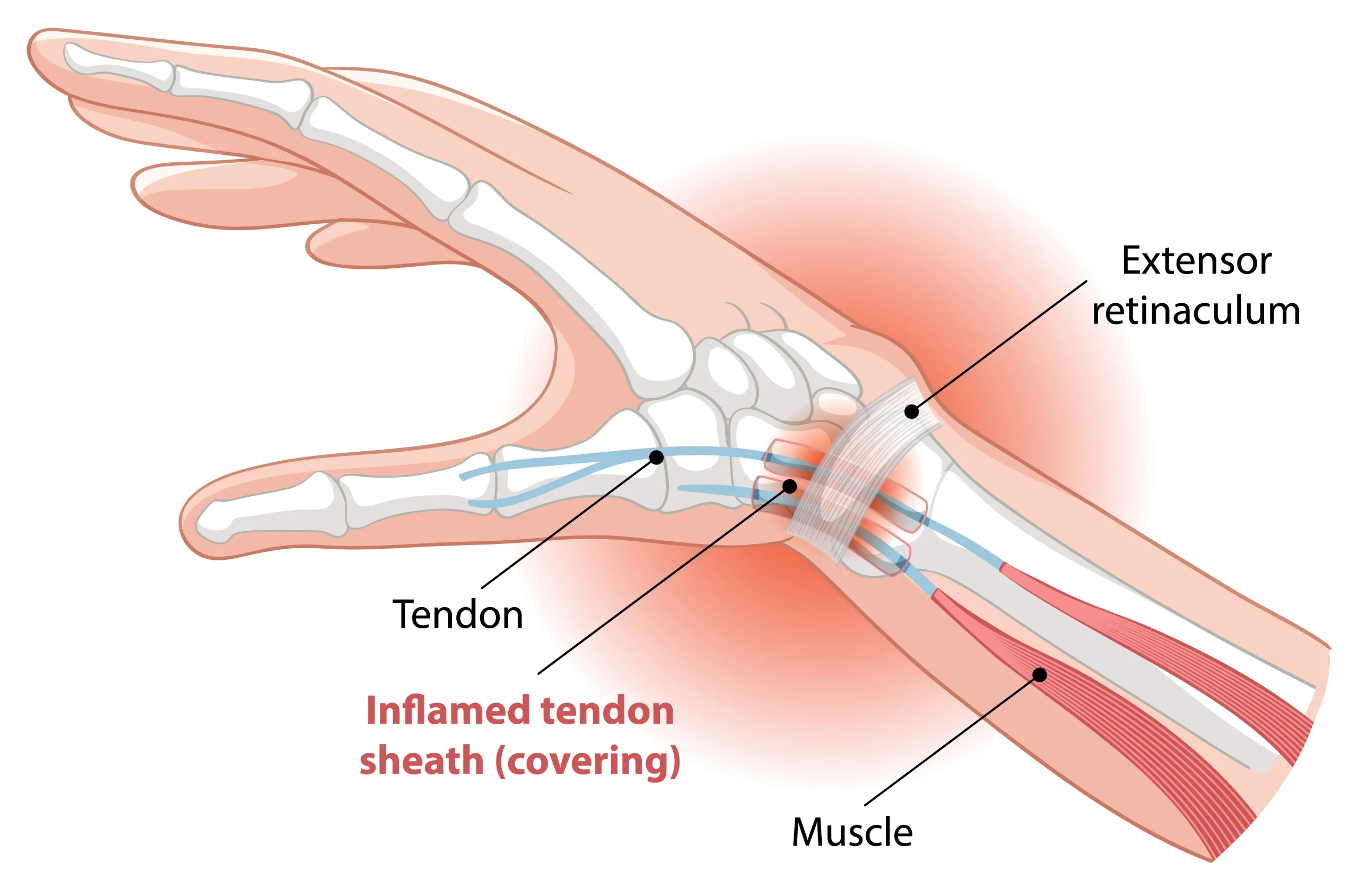De Quervain’s
De Quervain’s tenosynovitis is a painful condition affecting the tendons on the thumb side of your wrist. It often causes discomfort and can significantly impact your daily activities. Dr Oscar Brumby-Rendell is a renowned orthopaedic surgeon in Adelaide specialising in treating upper limb conditions, including De Quervain’s tenosynovitis, offering both surgical and non-surgical treatment options to help you regain full functionality and alleviate pain.

Understanding De Quervain’s Tenosynovitis
De Quervain's tenosynovitis is a painful condition that affects the tendons on the thumb side of the wrist. It occurs when the tendons that help move the thumb become irritated or inflamed, leading to pain, swelling, and difficulty with movement.
This condition is common in people who perform repetitive hand or wrist movements and is often seen in new mothers, office workers, and manual laborers.

Causes of De Quervain’s Tenosynovitis
The main cause of De Quervain's tenosynovitis is overuse of the wrist and thumb. Repetitive motions, such as lifting a baby, typing, or using tools, can strain the tendons, leading to inflammation.
Hormonal changes during pregnancy or after childbirth can also contribute to the condition.
- Repeated movements such as gripping, pinching, wringing, or lifting
- A direct blow to the wrist or tendon area
- Conditions like rheumatoid arthritis.
Symptoms of De Quervain’s Tenosynovitis
Symptoms often begin gradually and worsen over time. Patients typically experience pain and swelling at the base of the thumb, which may spread into the forearm.
Stiffness and difficulty moving the thumb or wrist are also common, particularly during activities that involve gripping or pinching.
-
Pain worsens with thumb or wrist movement.
-
A catching or snapping sensation may be felt when moving the thumb.
This condition can make it difficult to perform common tasks such as gripping, lifting, or even writing. Early diagnosis and treatment are crucial to prevent further complications and ensure a speedy recovery.
Diagnosis of De Quervain’s Tenosynovitis

A thorough physical examination by Dr Brumby-Rendell will assess your wrist and thumb for pain, swelling, and movement restrictions. A common test, called the Finkelstein test, involves bending the thumb into the palm and moving the wrist downward, which often reproduces the pain of De Quervain’s tenosynovitis. Imaging is rarely needed unless another condition is suspected.
Early and accurate diagnosis can prevent the condition from worsening and ensure that you receive the most effective treatment options. Dr Brumby-Rendell’s expertise in diagnosing musculoskeletal conditions guarantees a precise and timely assessment.
Non-Surgical Treatments
Benefits for New Mothers Who Cannot Rest Their Wrists
New mothers often develop De Quervain's tenosynovitis due to the repetitive lifting and holding of their babies. Rest may not always be possible, so alternative strategies such as wrist splints, posture adjustments, and supportive treatments can provide relief without disrupting childcare.
Surgical Treatments
Indications for Surgery
Surgery is considered when non-surgical treatments fail to relieve symptoms. Persistent pain, restricted wrist function, and difficulty performing daily tasks may indicate the need for surgical intervention.

Procedure Details
- Surgery to Reduce Tendon Pressure: The primary goal of surgery for De Quervain’s tenosynovitis is to relieve the pressure on the tendons. This is achieved by creating more space for the tendons to move freely.
- Cutting the Swollen Tendon’s Sheath: The procedure involves making small incisions to cut the sheath (covering) around the swollen tendon. This allows the tendons to glide more smoothly, reducing pain and improving movement.
- Minimally Invasive Techniques: Whenever possible, minimally invasive techniques are used to perform the surgery. These techniques involve smaller incisions, which can lead to quicker recovery times and reduced risk of complications.
The surgery is performed in a hospital operating theatre to ensure the highest standards of safety and care. Dr Oscar Brumby-Rendell and his team will provide a sterile and controlled environment for the procedure.
Recovery and Rehabilitation
Immediate Post-Operative Care
After surgery, the wrist may be bandaged and supported. Patients are encouraged to begin gentle movement soon after to prevent stiffness.

Typical Recovery Timeline
- Initial Phase (First Few Days): During the first few days, focus on managing pain, reducing swelling, and protecting the wrist with a splint or brace. This period is crucial for the initial healing of the surgical site.
- First Few Weeks: You will begin to notice a gradual improvement in symptoms. The pain and swelling should start to subside, and you will be encouraged to start gentle movements to prevent stiffness.
- One to Three Months: Most patients experience significant improvement in symptoms within this period. By the end of the three months, you should have regained a considerable range of motion and strength. However, full recovery, including the return of full strength and flexibility, may take a few more months, depending on individual healing rates.
Physical Therapy and Exercises
A tailored physical therapy program will help restore strength and flexibility to your wrist and thumb. Dr Brumby-Rendell may refer you to a physical therapist who will guide you through exercises to improve range of motion, reduce stiffness, and strengthen surrounding muscles. You may also receive exercises to perform at home.
Returning to Normal Activities
With proper care and adherence to your rehabilitation plan, you can gradually return to your normal activities. It’s important to ease back into activities and avoid any actions that could strain the wrist and thumb during the early stages of recovery.
Frequently Asked Questions
Scheduling a Consultation
Don’t let De Quervain’s tenosynovitis impact your quality of life. Reach out to Dr Oscar Brumby-Rendell clinic today by calling at (08) 7077 0101 or booking online. Take the first step towards your recovery.
Why Choose Dr Oscar Brumby-Rendell?
- Qualifications and Experience: Dr Oscar Brumby-Rendell is a locally and internationally trained orthopaedic surgeon with a fellowship through the International Bone Research Association. Located in Adelaide, he has extensive experience treating upper limb conditions, including De Quervain’s tenosynovitis.
- Patient-centred approach: Dr Brumby-Rendell is committed to providing personalised care, ensuring that each patient receives the best possible treatment tailored to their needs.
- Values: His dedication, passion, and commitment to excellence make Dr Brumby-Rendell a trusted choice for patients seeking effective treatment for De Quervain’s tenosynovitis.

Ready to learn more?
Watch more hand related injuries with Dr Oscar Brumby-Rendell.
Read more hand and wrist-related injury treatments by Dr. Brumby-Rendell here:
Once you have a referral…
Book your consultation here.
